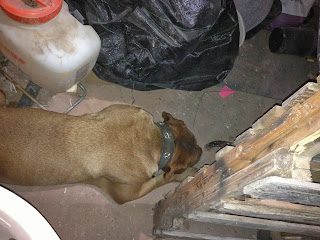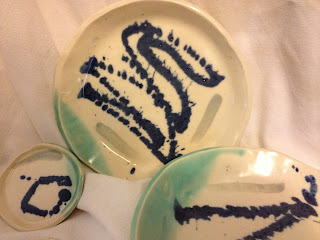First, my favorite bowl. The kiln, for reasons I don't recall, fired way too hot. It heated up to about a ^8 rather than ^6, our top temp. It literally ruined all the other pots in the glaze fire but Pikachu's cup and this bowl. It did strange things to our glaze and because of the circumstances it is not repeatable. I love that look and at the same time, the form of this bowl is very satisfying.
Folk Art is often described as primarily utilitarian and decorative rather than purely aesthetic. Other times as “naïve”
or “primitive”. Oddly there is even a
definition that Folk Art does not follow the traditional rules of proportion
and perspective, which is only true of some forms. I think it misses the idea that Folk Art,
unlike “fine art”, is not subject to current trends or fashions in the “art
community” but rather is grounded in the consumers of the art. In that, it is coming from a community and
tradition which grounds the art itself into rules not only about content but
process and materials.
Now, without a doubt the line between Folk Art
and “fine art” is a made up one, and to some degree is creates a straw man of
“fine art”, looking at the sometimes laughable craziness and attempt to create
something “novel” along with the “fine art” obsessive fear of being derivative.
This is not a fair characterization of art in general.
So why this randomness? Well, there has been
some discussion of creating an Artist Statement. And, if one reads far back
enough, I have had some discussion of the idea of being an Artist in general
and if, I am, in fact such a creature.
But I think that there is typical way that I go about the pottery that
I make in general, my wall hangings and masks being an exception. My work is functional, grounded firmly not
only in the utilitarian principles of good kitchen and tableware but more then
that. The design is echos of my appreciation of the American Slipware work and the
more practical end of the Studio Potter movement.
So this thought comes… while the more abstract
artist has a lot of freedom, the potter (rather than ceramic artist) is tied,
like a folk artist, into making something that has some firm rules and boundaries.
It is not a tea pot for a potter if you can’t make good tea in it. For a
ceramic artist it can be an expression and exploration of the idea of a tea
pot, or tea or the meal of tea…. But for the potter, a folk artist, it sure as
hell better pour right or it is trash.
With this, the folk artist and potter are
searching for an Ideal Form, a platonic ideal.
So the tea bowl, plate, pitcher and others… they are all judged in
comparison to a true form. And when it is right, or closer to right, it “rings
true” to the eye, to the hand and then ultimately it its use. I want my work to have a sense of movement,
to have life to it. This makes it not look like something poured or molded but
made by hand. Yet it must resonate with
the true form of the ideal pot. I don’t
know that is an artist statement, as it isn’t about me or my “journey” or in
any way, shape or form original. I think what I wrote could be true of a lot of
functional potters. And with a bit of editing, most folk artists. But that’s the
point now… isn’t it…




















































